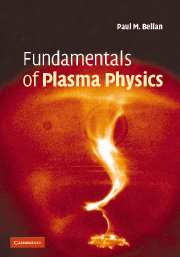Book contents
- Frontmatter
- Contents
- Preface
- 1 Basic concepts
- 2 The Vlasov, two-fluid, and MHD models of plasma dynamics
- 3 Motion of a single plasma particle
- 4 Elementary plasma waves
- 5 Streaming instabilities and the Landau problem
- 6 Cold plasma waves in a magnetized plasma
- 7 Waves in inhomogeneous plasmas and wave-energy relations
- 8 Vlasov theory of warm electrostatic waves in a magnetized plasma
- 9 MHD equilibria
- 10 Stability of static MHD equilibria
- 11 Magnetic helicity interpreted and Woltjer–Taylor relaxation
- 12 Magnetic reconnection
- 13 Fokker–Planck theory of collisions
- 14 Wave–particle nonlinearities
- 15 Wave–wave nonlinearities
- 16 Non-neutral plasmas
- 17 Dusty plasmas
- Appendices
- Bibliography and suggested reading
- References
- Index
11 - Magnetic helicity interpreted and Woltjer–Taylor relaxation
Published online by Cambridge University Press: 05 June 2012
- Frontmatter
- Contents
- Preface
- 1 Basic concepts
- 2 The Vlasov, two-fluid, and MHD models of plasma dynamics
- 3 Motion of a single plasma particle
- 4 Elementary plasma waves
- 5 Streaming instabilities and the Landau problem
- 6 Cold plasma waves in a magnetized plasma
- 7 Waves in inhomogeneous plasmas and wave-energy relations
- 8 Vlasov theory of warm electrostatic waves in a magnetized plasma
- 9 MHD equilibria
- 10 Stability of static MHD equilibria
- 11 Magnetic helicity interpreted and Woltjer–Taylor relaxation
- 12 Magnetic reconnection
- 13 Fokker–Planck theory of collisions
- 14 Wave–particle nonlinearities
- 15 Wave–wave nonlinearities
- 16 Non-neutral plasmas
- 17 Dusty plasmas
- Appendices
- Bibliography and suggested reading
- References
- Index
Summary
Introduction
The previous chapter introduced the concept of magnetic helicity via the energy principle and showed that total helicity K = ∫ d3rA · B is a conserved quantity in an ideal plasma. This chapter shows that helicity can be interpreted in a topological sense as a count of the linkages of magnetic flux tubes with each other. Furthermore, it will be shown that when the plasma is not ideal so energy is not conserved, helicity conservation remains a rather good approximation.
The greater robustness of magnetic helicity compared to magnetic energy in the presence of dissipation leads to the Woltjer–Taylor relaxation theory, which shows that a dissipative plasma will spontaneously relax from an arbitrary initial state to a specific final state. Relaxation theory has two remarkable features, namely (i) it sidesteps describing the actual MHD dynamics and simply predicts the end state after all dynamics is over, and (ii) it thrives on complexity so the more complicated the dynamics, the more applicable is the theory. The second feature results because increased complication simply provides more channels whereby the plasma can relax to the specific final state. Relaxation theory has been very successful at predicting the approximate behavior of many laboratory, space, and astrophysical plasmas.
This chapter concludes by showing that magnetic helicity can be manifested in different forms. In particular, the kink instability will be shown to be a mechanism that converts helicity from one of these forms (twist) to another (writhe).
- Type
- Chapter
- Information
- Fundamentals of Plasma Physics , pp. 385 - 409Publisher: Cambridge University PressPrint publication year: 2006



